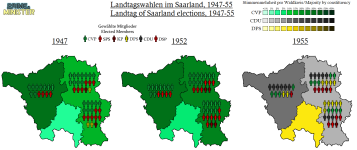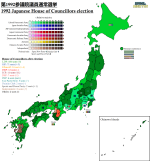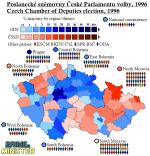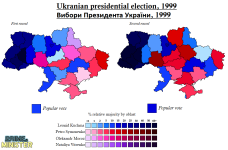I just realised I’ve been sitting on an Iceland 2009 map for ages and never got round to doing a writeup for it, which is a shame because it’s a fairly interesting election and I probably could’ve and should’ve a long time ago.
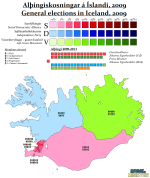
The 2009 election remains the high watermark for the left-wing
Social Democratic Alliance (SDA), though their current poll numbers are very healthy and there’s a possibility they could surpass that if they hold steady by the next election, and to date mark the only time since its founding that the
Independence Party has not been the biggest party in the Althing. The reason for these big reversals in fortune was, of course, the severe consequences of the Great Recession in Iceland.
The Independence Party had been in power continuously since 1991, first in coalition with the old Social Democratic Party from 1991 to 1995, then with Iceland’s other major party the
Progressive Party up until 2006, and then with the SDA (which had formed in 2000 after the three separate social democratic parties presented a joint list in 1999) after the Progressives pulled out of the coalition. Initially this had seen the SDA’s until-then meteoric growth take a hit, with the party losing seats at the 2007 election, not helped by the fact it had long been seen as too soft-left by a faction that proceeded to leave to form the green socialist
Left-Green Movement, but the Independence Party would proceed to spectacularly self-destruct in the brief parliamentary term that followed.
See, between 1991 and 2004, the Independence Party’s leader Davið Oddsson, had served as Prime Minister and enacted a swathe of privatisation and tax cut plans. While he had resigned due to a combination of an agreement with the Independence Party limiting his time left in office and a failed bill trying to establish restrictions on media company ownership that President Ólafur Ragnar Grímsson had vetoed, he served Minister for Foreign Affairs for a year and then became Governor of the Central Bank of Iceland. Under his watch, and arguably because of his government’s policies, the Central Bank would prove impotent when the Great Recession caused a crisis of confidence in three of Iceland’s biggest banks, Glitnir, Kaupthing and Landsbanki.
These banks had been expanding internationally, and now had assets 11 times the size of Iceland’s GDP and accrued the country 7 times that in external debt; the most obvious way this manifested was in the Icesave dispute where the UK and Netherlands claimed Iceland owed them the insurance for deposits investors there had made into Landsbanki before it folded. All three of the banks were taken into government ownership and renamed to try to distance them from the mismanagement which had led to their collapse, a humiliating development for the Independence Party, and most of their international operations were cut back, causing a decline in foreign involvement in Iceland’s economy; famously, a year later McDonald’s closed its last Icelandic branch, and the last ever cheeseburger brought there was turned into an exhibition piece by the buyer.
The public response to this is perhaps best summed up by a phrase popularised by comedian and later Mayor of Rekjavik Jón Gnarr in a comedy sketch on the end-of-year comedy special
Áramótaskaupið– ‘
Helvítis fokking fokk!!’, which apparently roughly translates as ‘What the fuckity fucking fuck!!’ and is officially my favourite slogan in the history of politics. In the winter of 2008-9, all hell broke loose with protestors demanding the resignation of Prime Minister Geir Haarde and for new elections to be called immediately; the protests were the biggest in Iceland’s history, and the police using tear gas on the protestors was an even worse look for the government. Another act of public disobedience, where people banged pots and pans to disrupt the Althing’s first meeting of the year, gave the protests their popular nickname- the ‘Kitchenware Revolution’.
In late January, Geir agreed to resign, citing his recent diagnosis of oesophageal cancer and definitely nothing else, and Ólafur invited the SDA’s Social Affairs Minister Jóhanna Sigurðardóttir to form a coalition with the Left-Greens. Jóhanna was one of the only government ministers whose conduct the public approved of, and had a good working relationship with the Left-Greens even though they didn’t command a majority in the Althing combined, which stood the two left-wing parties in good stead for the election Jóhanna proceeded to call.
That election would see the combined left win a majority in the Althing for the first time in history, with the Independence Party losing nearly 13 percentage points and 9 of its 25 seats (it likely only avoided losing more thanks to interim chairman, and later PM and Centre Party leader Sigmundur Davíð Gunnlaugsson, accepting the public demand for an early election). The Left-Greens even topped the poll in the Northeast constituency where its leader Steingrímur J. Sigfússon is based. The newly-formed
Citizens’ Movement also won 4 seats, a sign of how the Kitchenware Revolution would give rise to minor parties in Iceland for quite some time to come.
While the new government would be famously radical in many areas, notably including Jóhanna’s status as the world’s first LGBTQ person elected as a head of state, its ban on strip clubs and its invocation of the
Landsdómur (national court) for the first time ever to try to convict Geir for misconduct during the financial crisis, it ended up falling short in many others. Davið Oddsson faced few consequences, becoming editor of the
Morgunblaðið newspaper in September 2009, a post he holds to this day; attempts at a new citizen-drafted constitution proved heavily protracted; and the SDA’s efforts to bring Iceland into the EU were stymied by opposition from across the political spectrum, especially with the Icesave dispute damaging trust in European cooperation.
The SDA-Left-Green government would ultimately office after a landslide defeat in 2013 having run out of time to push for many of their reforms and lost popularity over their handling of others, with a new Independence-Progressive coalition being formed which unceremoniously threw out the constitutional plans and attempts to join the EU.




